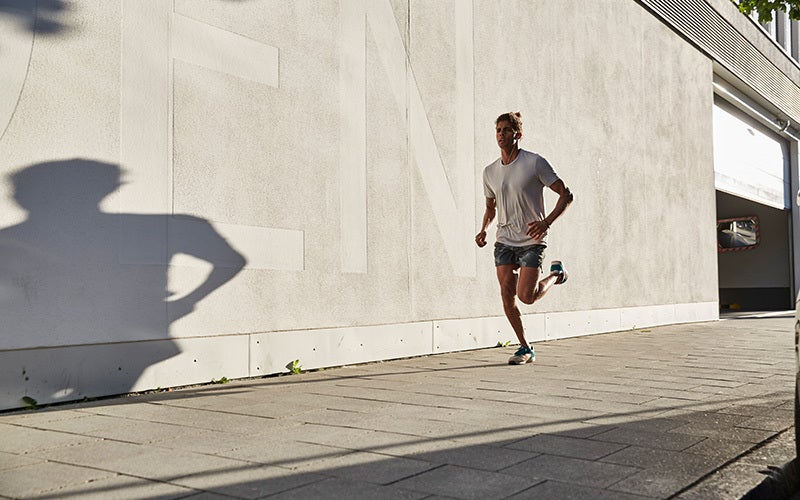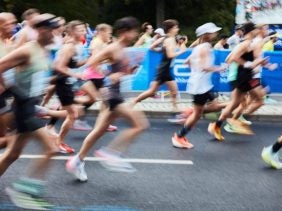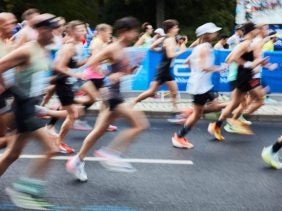How to Start Jogging: Everything you need to know
 ©alvarez
©alvarez
With warmer weather officially here, it’s the perfect season to go jogging. If you haven’t done it much, though, you might not know how to start jogging. In this article, we explain everything you need to know to get started, from whether or not it can help you lose weight and build muscle, to how much and how often you should do it.
Jogging Basics: 7 Tips to Get Started
Going on a run is one of the least complicated forms of exercise there is. You don’t need any special equipment—just a pair of trusty running shoes and you can hit the pavement. The main thing you should focus on doing when you get started is learning how to enjoy running. These seven tips will help you do just that:
1. Be realistic.
Don’t try to run a marathon before you’ve even run a mile. The odds are you probably won’t be very good at running right when you start, because, like any other physical activity, it takes practice to be able to run 5km in 30 minutes. Start small and gradually you’ll be able to do more. Try running in 1 to 2 minute bursts and take time to walk and recover in between. Shorten your breaks over time and before you know it you won’t be taking them at all. To get into the habit of running, start by doing it twice a week.
Running is much more fun when you don’t overdo it. Instead of forcing yourself to run every day, you’ll make faster progress by running every once in a while, without overdoing it. Because if you do overdo it, your body will feel the consequences, and it may take longer before you’re ready to get back out there. Don’t rush yourself — give your body the time it needs to recover and grow stronger.
2. Set goals for yourself.
Having a goal in sight can be just what you need you to motivate yourself to run. Set goals and make them as concrete as possible. Did you start running at the beginning of April? Then your goal could be something like this: I want to be able to run 5 km in 40 minutes by July 15. Or 10 km in less than 45 minutes. Set a goal that is both realistic and motivating.
3. Make a clear plan.
You’ll be more likely to reach your goal if you have a concrete plan that tells you exactly when you’re going to run, how far you’re going to run, and how often you’ll run per week.
Having trouble finding time to run? Then build time slots into your calendar to help you stick to it.
Running tips: If you want to save time, consider a run commute. It is what it sounds like: You run to work from home instead of using whatever transportation you normally rely on. Obviously it’s not possible for everyone, especially those who don’t have access to a shower at their office or are too far away to run the distance. But if it is possible, know that it’s a great way to incorporate running into your daily routine.
And if you don’t feel like making a plan yourself, consider using one of ours! We can make it easier if you want to read up on basic endurance. For advanced runners, training with a heart rate monitor is an ideal way to monitor and improve your endurance.
4. Measure your progress.
Seeing that you’re making progress is motivating. Track your runs with an app on your phone that records your exercise and progress. If you don’t have one, you can also keep a journal or logbook in which you enter the distance you’ve run and how fast you ran. If you feel less motivated over time, open your log and see how much progress you’ve already made since day one. You should be proud of yourself!
5. Look for a jogging partner.
Yes, it is possible to share a conversation while running! If you’re just beginning to run, consider finding someone to do it with you on a regular basis. Instead of catching up over a coffee or, plan to meet-up for a workout instead. It’s fun and healthy!
6. Find your inspiration.
Sometimes our motivation leaves something to be desired. And when it’s cold and raining? Forget about it! Following inspirational content is one easy way to keep yourself motivated. Social media and magazines are brimming with stories about inspirational runners from all around the world. And there are plenty of interesting newsletters that provide plenty of health and fitness tips to help you keep your eye on the prize. Motivated every day by the success of others, you’ll definitely want to get involved too!
7. Get some awesome running gear.
Though you might be wondering what fashion has to do with running, the right pair of running shoes can really make a world of difference. They shouldn’t just look good, though — they should fit your feet and feel comfortable when you walk or run. You’ll know right away if the shoe is right for you because it’ll feel good from the very first step you take.
However, the type of shoe you’ll need really depends on the anatomy of your foot, as well as the position of your hips and legs. The best way to find out is at specialized shoe stores, which offer free treadmill running analyses to help you find out.
And the best part is, running gear doesn’t begin and end with running shoes! There are tons of elegant and ergonomic sportswear to choose from. Many leggings, tops, and sports bras are designed with state-of-the-art technology that enables them to absorb moisture from the body while keeping you warm and dry. Winter sportswear even features an array of thermal insulated clothing.
But if your budget doesn’t allow for it, a cotton T-shirt and light shorts will be the perfect outfit to start with—as long as the running shoes are good enough.
The golden rule: don’t dress too warmly! It’s best to dress in layers. Start with a base layer and add as many layers as you need of lightweight clothing over it. You can easily remove or put them on again depending on your temperature. Our tip here? It’s not a problem if you feel a little too cold right at the start of your jog. You’ll warm up quickly, and might regret bringing along even more layers than you needed.

How do you jog properly?
Jogging properly is simple. If you already know the basics and are ready for your first run, that’s great! But if not, take the time to read these tips and tricks to make sure your first run is a success:
Find the right pace
To find the right speed to run at, here’s the rule you should use: You should be able to run without panting. If you can still talk, but aren’t able to sing (we aren’t all Beyonce), then you’ve found your ideal jogging pace.
The pace you choose also depends on your goal. The pace for interval training is much faster than that of basic endurance training, because you’re doing the latter for only short bursts of time and the former for longer periods of time. The pace for endurance running, on the other hand, should be somewhere in the middle.
Don’t hesitate to mix it up
Boredom kills motivation. Bringing variety to your route and pace will keep you both motivated and interested. Try taking a different running path once a week, or, when you feel ready, you could change your tempo. Go fast for a few meters, then go slower again.
Make sure you get in some other training
Jogging can’t be your only workout — even for beginners. Try to plan at least two strength training sessions a week, one of them focusing on the core (because it’s your core strength that will help you prevent long-term running injuries).
When you do your other workouts, focus on muscles that get little to no attention during your jog. This will improve your running performance and protect you from injuries. Bonus: strength training defines muscles and stimulates weight loss, if that’s something you’re interested in.
Stay flexible
Running always uses the same muscles, and the more they get used, the more they contract and become increasingly rigid. All that muscle tension can help you develop muscle tone, but it can also cause injuries if you’re not stretching them out.
In general, low flexibility means you’re more likely to get injured during a workout, but it’s easy to fix with simple stretching. Before running it’s important to stretch your legs and hips in particular to keep them maintained during your workout.
A flexibility and mobility workout done regularly (on a recovery day or 2 to 3 times a week before training) is great for improving flexibility, keeping the fascia flexible, and avoiding running injuries.
Get plenty of rest
Anyone who exercises regularly needs plenty of time to recover. During a workout, you’re straining your body way more than it’s used to. On the plus side, your body learns fast. It builds extra muscle tissue so that it is better prepared for next time. Your lungs’ capacity to absorb oxygen and endurance abilities will also gradually improve.
All of this means your body will be ready to go the next time you work out. This principle is known as supercompensation, a post-workout period during which your performance capacity is greater than it was before training. However, if you don’t give your body enough time to recover after two sessions, you may accidentally overtrain, which could cause injuries and leave you feeling totally exhausted.
With enough rest time and a healthy lifestyle, you encourage your body to regenerate itself. These are the 5 ground rules:
- Eat well and eat enough.
- Ensure you’re getting a good balance of macronutrients.
- Stay hydrated.
- Get enough sleep.
- Make sure to relax.
Jog, and do it well
Can everyone run? Yes, they can, but, of course, some are more naturally suited to it than others. Running the right way is not only pleasing to the eye, but more fun in the process — not to mention, better for your health!
Here are 5 running basics you need to know:
- Foot position: Try to place the middle of your foot on the ground. Make sure you’re putting your foot gently on the ground — don’t make it “bounce.”
- Step length: Seen from the side, your foot should be only slightly offset from your hip. When your foot touches the ground, your knee should be only slightly bent.
- Stride rate: The optimal stride rate varies with your pace and is approximately 160 to 190 strides per minute, or 140 to 160 for beginners. You can calculate your stride rate by counting for exactly 30 seconds how often your right foot hits the ground. Multiply this number by 4 to get your stride rate.
- Posture: Jog straight with a steady upper body. Your hips should be pulled back. Seen from the side, you should be able to draw a straight line from your ear, through your shoulder, to your hips, down to the ground. Check your posture periodically by glancing at your reflection in a window or a side mirror on a car you’re passing by.
- Arm position: Your upper arms should always be to the side, along the body, never positioned in front. The forearms should swing slightly backwards.
It’s easier than it looks. With a little time and practice you will improve and become faster.

Burning Calories with Running: Losing Weight and Building Muscle
Running: is it effective for losing weight and building muscles?
If you do it right, running can be an effective way to lose weight and build muscle. Running keeps the cardiovascular system in shape, is inexpensive, convenient, and time-saving: you can start anytime, anywhere, and do it for as long and as fast as you like.
Here’s how to lose weight when you start running
As a rough guide, you burn an average of 1 calorie per kilo of body weight per kilometer during a jog. With a weight of 50 kg, you burn about 300 kcal when you run 5 km and 500 kcal when you run 10 km.
How many calories you actually burn depends on various factors. Age, gender, health, intensity of the run, and additional exercise, among other things, all play a role. Here are our tips for losing weight through running:
- Make sure you’re cutting 200 to 500 calories out of your daily diet.
- Combine interval training with endurance training. High-intensity interval training (also known as HIIT training) burns a lot of calories and gives you a strong afterburn effect. Long, slow jogs result in high fat burning.
- Give yourself a break. If you don’t include break days in your workout, the stress hormone cortisol increases, blocks fat burning, and can cause you to eat more than you intended. For beginners, two running sessions a week is a good start.
How long you need to jog to burn fat cannot be generalized, but also depends on your diet, metabolism, and health. The fact is that as soon as you start running, you burn fat, but it’s important to remember to jog fairly slowly.
Is it possible to build muscles while running?
As we have seen, running does not make your muscles grow, but it can improve your performance. In other words, running does not build muscle mass. In fact, the opposite is true: your muscles will become thinner and firmer. If you want to build muscle and still run, here’s our advice:
- Plan on eating an extra 200 to 500 kcal a day. To find out how many calories you should consume to reach your goal, use our calorie calculator.
- Jog slowly and for a long time. This way you will burn fat more efficiently and tone your muscles.
- Don’t exhaust yourself running. Instead, save the energy you have left over for strength training.

Which muscles does running work out?
When running, we’re mainly working out the leg muscles: the calves, the shins, the front and back of the thighs, and the hips.
Since the whole body is in motion, the other muscles are also involved in the movement. However, in order to develop or define certain muscles in a targeted manner, strength training is a necessity.
Is it a bad idea to jog when you’re sore?
Running when you have sore legs, glutes or hips is a big no! Soreness means that you have small tears in your muscle tissue. This is not serious (normally) and usually heals within a few days, or up to a week of rest at the latest.
However, the muscles first need time to recover completely. If you do go running while you’re still sore, you may further damage the muscle fibers. The body will not develop new muscles during this time, but will continue trying to regenerate the damaged ones.
In other words: running while you’re sore isn’t going to help you. That doesn’t mean you should stay home and relax! If your legs are tired, you can always work on your upper body. Or go for a walk. Moderate exercise (yoga, stretching, a brisk walk, or Pilates) all stimulate blood circulation and supply your muscles with oxygen.
People who exercise a lot and sweat a lot often need more minerals and vitamins, too. Zinc and magnesium are ideal for getting your body into “recovery mode” after training.
Running and diet: Here’s what you should pay attention to

Diet has a major influence on the way you exercise. What you eat before a workout determines how you’ll feel during when it happens. What you eat after exercise determines how you’ll recover.
To find out what’s best for you to eat, consider how certain foods make you feel. What gives you energy, and what makes you feel sluggish? What you eat is important whether you’re training for a marathon or half marathon, or if you simply want to improve your performance in a targeted way.
Do you just want to jog in order to lose a few pounds or tone up your muscles? All you have to do is eat fewer (or more) calories to make it happen.
In general, here’s the rule of thumb: before jogging, eat healthy carbohydrates; afterwards, eat carbohydrates and protein. With this combination, you can’t go wrong.
Our conclusion
- Give yourself some time. Start off by creating or finding a plan and following it.
- Find a partner to help you get started.
- Take breaks between runs.
- Running builds endurance and can help you lose weight.
- Running can help build muscle.
- Your running pace will depend on your goal.
- Don’t run when you’re sore.
- A balanced diet rich in high-quality carbohydrates and protein is a perfect complement to your new running regime.
Sources for this article
We at foodspring use only high-quality sources, including peer-reviewed studies, to support the facts within our articles. Read our editorial policy to learn more about how we fact-check and keep our content accurate, reliable, and trustworthy.

































